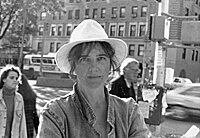Guest blogger Dan Fiebiger with his hand built “Dan-Cam”, a 35mm motion-control animation system.
Dan Fiebiger Remembers The Center For The Moving Image: A Four Part Series by Dan Fiebiger continues here with Part Two:
(Here is Part One, for those who have missed it.)
Part Two by Dan Fiebiger
As I mentioned, Tom Shaw loaned CMI a “four-gang” 16mm film editing synchronizer. Pictured below is a “4-gang” unit for four strips of film much like then one CMI used. But the “synker” we had and used also had a “sound reader head” attached to top of the front “gang” for reading soundtracks on “full coat” magnetic film.
16mm film “4-gang synker”
“Full coat” means the entire width of the film is “fully coated” all the way across the width of the film with iron oxide for recording sound on film. 35mm film comes in “full coat” also, but can also be bought in “mag strip” form with only part of the film containing magnetic oxide which is cheaper to buy than “full coat”.
The editing “bay” (fully assembled editing table) also had a large rectangular hole in the table on either side of the synker with a garbage bag-sized cloth-bag attached to the underside of each hole for film to fall into while it was being edited. Film rewinders were on either far side of the editing table for taking up slack in the film. The Shaw-CMI synker had a small viewing screen mounted on the “gang” farthest from the operator for seeing the image. This primary editing sytem was in one of three small editing rooms that had been built in one of the classrooms that became CMI . They also had a couple small 16mm independent film viewers and rewinders in a couple of the secondary secondary editing rooms.
Film rewinders
Meier-Hancock 16mm film splicer for “wet” (film cement) splices. CMI had one of these.
Semi-quality QTS “Ediquip” 16mm film tape splicer. CMI had one of these.
Basic 16mm film viewer for CMI secondary editing rooms, CMI had 2-3 of these.
Semi-typical 16mm “editing bay” CMI set-up, except the Shaw-CMI system had two big holes in the table on either side of the “synker” for excess film flow. Pictured above is more like the two secondary editing rooms that CMI had.
CMI couldn’t afford more elaborate editing systems like a “Moviola” or a “flat bed” editing table made by companies like Kem or Steenbeck. CMI’s 16mm magnetic film recorder had also seen better days, and due to a heavily worn-recording head had lost much of the high frequencies, reproducing nothing much higher than about 2-3 K cycles per second. (16mm film can reproduce up to about 5-6 K, 35mm up to about 12-15-K, and digital can reproduce up to about 20-K. ”K” = each thousand cycles-per-second.) During the transfer from any source on CMI’s 16mm mag film recorder, it always made for some pretty muffled sound on the final films that used sound recorded on it.
Fancier editing systems existed in those CMI days, but CMI couldn’t afford them.
CMI’s editing rooms were hardly the dust-free “Clean Rooms” normally used for professional film editing, and so dust (etc.) would often get on the ‘original’ film (and wind up on the final film prints) pretty easily. At least Tom Taylor taught us the proper use of white cotton gloves when handling film to avoid getting body oils and fingerprints on them.
When taking classes at CMI, you got the impression that PSU couldn’t care less if CMI thrived or not, for lack of funding to buy better quality (and more) equipment. Typically impoverished students had to pay all their own lab expenses for any and all of their CMI film projects, in addition to the tuition for taking the classes. One wonders if Tom Taylor and Andries Deinum even got a salary and taught the classes just for occasional scraps of food and the love of the film.
Both of them obviously had a hatred of the Hollywood system and a love for independent films.
Tom Taylor’s textbook and bible was “Independent Filmmaking” by Lenny Lipton, which was full of good “Indie” film info, but had nothing about the Hollywood system that I also wanted to learn, nor any info on why the Hollywood system was so riged and hard to break into, thus fostering a hatred of it by most “Indie” filmmakers. I had to slowly learn all that politics the usual random hard way as the years progressed in my life.
Here’s the original 1972 first edition of Lenny Lipton’s “Independent Filmmaking” that Tom Taylor used for CMI classes:
Always soft-spoken Tom Taylor was a genius at shooting “fly-on-the-wall” documentary films, inspired by premier documentary filmmaker Frederick Wiseman’s unobtrusive filmmaking techniques where his subjects hardly noticed him as he shot his films. Tom always loved documentary film over narrative films, and ignored teaching any of the standard Hollywood rules of narrative filmmaking such as scripting, pacing, elaborate editing rhythm, art direction, composition, camera movement, color timing, post-production EFS, sound design, use of music, etc. Instead he emphasized simply filming “what was happening as it happened,” spontaneously, unrehearsed, to get the “immediacy of the moment” captured on film. Tom was always more interested in teaching film esthetics rather teaching all the potential nuts and bolts technical side of filmmaking, although he taught some of that also as a necessity.
=========================================================
Continue reading the rest!
Dan Fiebiger Remembers The Center For The Moving Image: A Four Part Series continues with


0 responses so far ↓
There are no comments yet...Kick things off by filling out the form below.
Leave a Comment